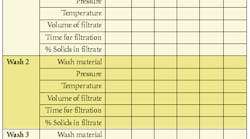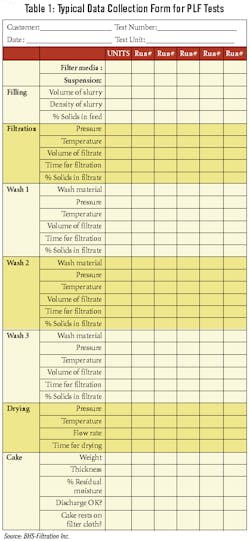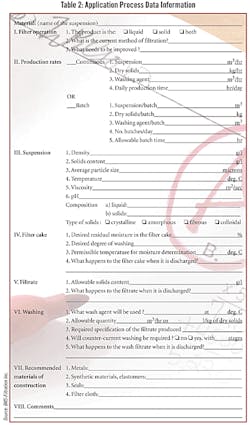Solid,"liquid separation by pressure or vacuum, cake washing and drying are integral to producing a chemical or pharmaceutical product or for fluid clarification and recovery. A number of competing technologies and options can be employed to accomplish these steps, including nutsche filters, centrifuges, belt filters, filter presses, pressure plate filters and others. This article concentrates on the testing of pressure or vacuum operations. Centrifugation testing is conducted in a similar manner, generally using a bucket "bench-top" centrifuge to gather data.
In solid,"liquid separation systems, a wide variety of parameters influence performance. Evaluation and testing procedures can help plants determine the effectiveness of a particular system. Parameters that can be evaluated include particle size and shape, particle type, density, concentration, viscosity, cake height, pressure or vacuum, filter media, batch or continuous operation, required production throughput and more.
Theoretical calculations of filtration performance (Darcy's Equation and other modeling techniques) are far from easy, but can be useful. Creative problem-solving, however, continues to be a primary task of process engineers. The selected internal or external filtration testing personnel must have the ability to combine theory and practice.
Pocket-leaf filter testing
Bench-top testing first must be used to narrow the gap between theory and practice and to begin the equipment selection process. A useful bench-top filter system is a pressurized pocket-leaf filter (PLF), which resembles a Buchner funnel. The figure shown on the next page illustrates a typical PLF unit.
The PLF shown has a filter area of 0.002 square meters (sq m) and consists of a pressure vessel (90 pounds per square inch [psig] to full vacuum), a top cover with a pressure gauge and gas (or air) connection and a bottom base for the filter media and filtrate outlet. The pressure vessel and base are jacketed and can be heated or cooled with a heat-transfer medium. The filter media can be synthetic single-layer metal or multi-layer sintered metal. The materials of construction are 316 Ti stainless steel, Hastelloy or polypropylene, and the fill volumes range from 250 milliliters (ml) to 2,000 ml.
A number of items are required for accurate PLF testing, including:
Material Safety Data Sheets (MSDSs) for all materials.
4,000 ml to 8,000 ml of representative-quality feed material for each material to be tested.
2,000 ml of wash material for each wash.
A 1,000 ml to 4,000 ml closed container with mixer to use for the feed material before each run.
Several 250 ml to 500 ml containers for the feed material, the filtrate, the fresh wash material and the wash filtrates.
Small containers for the filter cake.
A gram scale.
A vacuum oven or other technique to check the percent solids in the feed slurry, filtrate (mother liquor) and wash filtrates, as well as the percent moisture in the filter cake by a Karl-Fischer analysis or other technique.
Gloves and breathing equipment.
A regulated air or gas supply that can be controlled at 90 psig.
A flowmeter on the air or gas supply. The flowmeter allows the air or gas flow rate to be measured during the drying step.
A heat-transfer medium (hot oil, glycol, steam or cooling liquid).
A vacuum source.
A specific test apparatus to measure data such as pH, conductivity, particle size after completion of the testing cycle, etc.
Representative Sample. The sample must be representative of what is to be found in the actual process, including particle size distribution, particle shape, viscosity, temperature, etc.
Testing location and personnel. Several options are available for the testing location. The first option is the plant's lab or pilot plant. This approach offers the best chance of a representative sample and provides easy access for all process engineers involved in the project. However, testing often will conflict with the plant's production requirements. Furthermore, time conflicts could exist, so it is important to determine who would conduct the testing at the plant site ," the plant's or the vendor's process engineers. If it is the vendor's engineer, then safety training, laboratory access and other concerns must be addressed.
A second alternative is to conduct the tests at the vendor's laboratory using process materials produced at the plant. This approach allows focused testing with little or no interruptions. In this case, it is important for the process engineer(s) to evaluate the vendor's laboratory, as well as the vendor's process personnel who will be conducting the tests. If possible, the plant's process engineer(s) should be invited to witness and help perform the tests; they will be familiar with the "quirks" of the process and product.
PLF Unit
Source: BHS-Filtration Inc.
A third alternative combines the first two approaches. Both the process reaction and the filtration tests are performed in the vendor's laboratory. In this case, either the vendor or the plant process engineer(s) would supply the necessary process chemicals to conduct the reactions and/or precipitations. The resulting slurry then would be fed immediately to the PLF to begin the testing.
This approach offers benefits in that the sample is representative, the testing is focused, reaction/precipitation parameters can be modified to improve the filtration results, and a holistic approach to testing is implemented.
Required data and data collection. The testing objectives could be to expand plant production, decrease cycle times, maximize wash efficiencies or achieve another goal. Table 1 shows a typical data collection form that can be used for bench-top testing with the PLF unit. Table 2 illustrates the data about the process that are required, slurry, washing media and, most importantly, the testing objectives.
Testing procedures
Pressure or vacuum filtration. The first optimization is the filtration rate. A premeasured amount of slurry is added from the top. Pressure or vacuum filtration begins, and the amount of filtrate vs. time is recorded.
Parameters that are varied sequentially in this step include cake depth, filtration pressure or vacuum and filter media. For thin-cake filtration technologies, cake depths can vary between 5 millimeters (mm) and 25 mm. Maximum cake thickness for the PLF unit is 150 mm.
Displacement washing. Displacement washing is performed after the filtration step is completed. A measured amount of wash liquid is added carefully in a predetermined wash ratio so the cake is not disturbed. Once again, pressure and time are measured. One or more wash tests can be conducted with the same or different wash liquids.
Cake pressing. Several thin-cake technologies can perform cake pressing or squeezing. The PLF can simulate this pressing procedure with a "pressing plug." The pressing plug is actuated by nitrogen pressure and squeezes the cake onto filter media. This pressing can be conducted before, during or after the filtration, washing and drying steps.
Drying. Product drying in the PLF is tested by blowing ambient-temperature or hot gas through the cake or via vacuum. In addition, both the vessel jacket and base jacket are heated to simulate a production unit. The pressure is kept constant, and gas throughput is measured vs. time. After a preselected drying time, the cake is removed, and the cake depth and weight are determined. The cake then is analyzed for moisture content. Several iterations are required.
Results and analysis. Once testing is completed, the vendor's process engineers analyze the data to recommend one or more filtration technologies. The test report includes an executive summary, test objectives, test methods and facilities, test data (in table form), test results (in written and graphical form, including filtration and drying curves), recommendation of production equipment and scale-up and any other recommendations and "path-forward" action steps.
Based on the PLF tests and recommendations, pilot-scale tests can be conducted. These tests should most often be conducted at the plant site using actual feed material from the reactor, as well as the actual washing and drying media, operating conditions, etc.
It is also important for the plant to ensure the same vendor engineer who conducted the PLF tests conducts the pilot tests. The testing procedure and testing "tricks" employed on the bench-top, therefore, also will be employed in the pilot testing.
Conclusions
Currently, the most efficient approach to selecting and/or optimizing a pressure or vacuum filtration system is to use a PLF unit. With assistance and process support from the vendor and accurate data from the testing ," combined with filtration theory and experience ," proper selection, scale-up, optimization and process guarantees can be realized.
Perlmutter is president and managing director of BHS-Filtration Inc., Charlotte, N.C. Contact him at [email protected].





